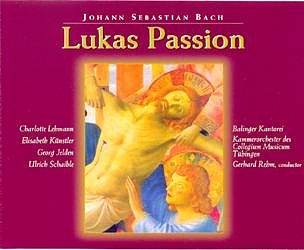According to one of his obituaries (c-written
by his son C.P.E. Bach), J.S. Bach wrote five Passions, though
one of these might have been a version of the St. Matthew Passion
with just one chorus instead of two. And we have the text of his
St. Mark Passion, which has been reconstructed by a number of
musicologists. Regarding the fifth passion, we have just faint
echoes and a manuscript. This is in the hand of Bach and his son
C.P.E Bach, the majority in C.P.E.'s hand. Bach was wont to copy
out scores for use at Leipzig (his copy of Handel's Brockes Passion
is earliest surviving copy of that work) and this St. Luke Passion
was undoubtedly performed at Leipzig. But whether the Passion
is by J.S. Bach has been exercising musicologists ever since.
Both Mendelssohn and Brahms saw the manuscript and expressed their
opinions (both doubting Bach's authorship). There have even been
suggestions that it is an early work by C.P.E. Bach.
But, whoever its composer, this is a charming
work and its performance enables us to shed more light on the
background to Bach's two major Passions. The first surprise, on
listening to it, is the complete difference in atmosphere to Bach's
later passions. This St. Luke Passion is essentially a sequence
of recitatives alternating with chorales. Lightly orchestrated
with just secco recitative (no accompanied recitatives here),
it is a gentle, rather old-fashioned sounding work.
There are two soprano arias, two tenor arias
an alto aria and a Terzetto for two sopranos and alto. There are
over thirty chorales and over a dozen choruses. All the chorales
are quite short and only the opening chorus ('Furcht und Zittern')
is of any length. The result is quite a fast-paced narrative,
cramming over 100 numbers into under two hours of music. On this
recording, some of the Chorales are sung, one voice to a part,
by the soloists and in other choral movements, the soloists act
as a semi-chorus in contrast to the main body of the choir. As
the CD lacks any kind of notes, I am unclear whether this is something
that the conductor (Gerhard Rehm) has decided, or whether it is
specified in the score. Either way, it makes for an attractive
way of varying the texture of the piece.
The full choir have few opportunities to sing
any developed music but they acquit themselves creditably. They
are, regrettably, recorded rather far back. When acting as semi-chorus
in the chorales, the soloists display a little more vibrato than
is desirable, but the effect is never too unpleasant. But with
so many chorales, they do start to sound rather four-square, as
if the conductor was anticipating that we join in at home. I would
have liked far more flexibility.
Gerhard Rehm's view of this work overall is a
little simplistic. His reading has a tendency to dourness and
can lack charm. And his speeds are rather slow, particularly in
the recitatives. There are many of them and Georg Jelden, the
Evangelist seems to make heavy weather of them. His performance
is fine, but I would have liked more lightness, speed and flexibility.
(The performance of the passion recorded by the Bremen Baroque
Orchestra manages to knock over ten minutes off the timing for
the work).
None of the arias plumbs the depths in the way
that we expect from J.S. Bach, but they are efficient and charming.
They are decently sung here, though the notes fail to identify
which person is singing what. The most arresting moments are those
involving the chorus and the soloists acting as semi-chorus, and
the charming Terzetto 'Weh und Schmerz'. The composer includes
another imaginative touch at the moment of Christís death, when
a chorale, played twice by the winds of the orchestra, frames
the chorale sung by the choir. This is followed by a long tenor
aria (sung here, I think, by the Evangelist) which almost obsessively
repeats the musical material based on the wind chorale.
This is a decent performance and all the soloists
acquit themselves creditably. But I did not think that its sober,
sombre mien brought out the best in the work. This is not the
St. Matthew Passion, nor even the St. John. I would like to hear
it in a lithe, original instrument performance that allows the
piece's essential charm to appear.
But, if you are curious about Bach's 'other'
Passion, then this recording, at super budget price, is a reasonable
enough way for you to satisfy your curiosity. There are no notes
and no libretto. Normally this does not matter, but with such
a rarity this might prove a drawback.
Robert Hugill
